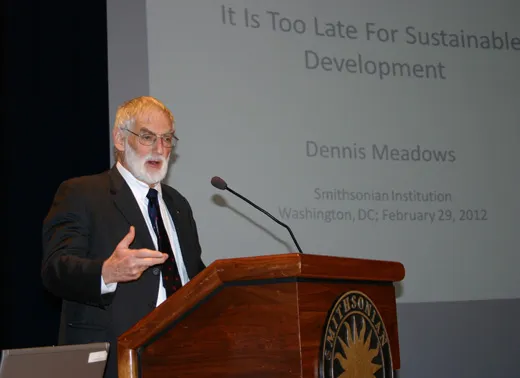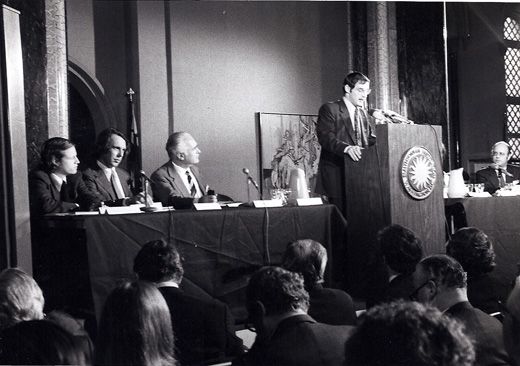Is it Too Late for Sustainable Development?
Dennis Meadows thinks so. Forty years after his book The Limits to Growth, he explains why
/https://tf-cmsv2-smithsonianmag-media.s3.amazonaws.com/filer/Dennis-Meadows-Limit-Growth-QA-631.jpg)
On March 2, 1972, a team of experts from MIT presented a groundbreaking report called The Limits to Growth to scientists, journalists and others assembled at the Smithsonian Castle. Released days later in book form, the study was one of the first to use computer modeling to address a centuries-old question: When will the population outgrow the planet and the natural resources it has to offer?
The researchers, led by scientist Dennis Meadows, warned that if current trends in population, industrialization, pollution, food production and resource depletion continued, that dark time—marked by a plummeting population, a contracting economy and environmental collapse—would come within 100 years.
In four decades, The Limits to Growth has sold over ten million copies in more than 30 languages. The book is part of the canon of great environmental literature of the 20th century. Yet, the public has done little to avert the disaster it foretells.
To mark the report’s 40th anniversary, experts gathered in Washington, D.C. on March 1. Meadows and Jorgen Randers, two authors of The Limits to Growth, and other speakers discussed the challenges of forging ahead into a sustainable future at “Perspectives on Limits to Growth: Challenges to Building a Sustainable Planet,” a symposium hosted by the Smithsonian Institution and the Club of Rome, the global think tank that sponsored the original report.
I spoke with Meadows, who retired in 2004 after 35 years as a professor at MIT, Dartmouth College and the University of New Hampshire. We discussed the report and why he feels it is too late for sustainable development and it is now time for resilience.
From 1970 to 1972, you and 15 others worked feverishly on The Limits to Growth. What were your goals at the outset of the project?
Jay Forrester, a senior professor at MIT, had created a theoretical model that showed the interrelationship of some key global growth factors: population, resources, persistent pollution, food production and industrial activity. Our goal was to gather empirical data to test his model and elaborate on it. We wanted to understand the causes and consequences of physical growth on the planet over a 200-year time period, from 1900 up to 2100.
According to the “standard run” or “business-as-usual” scenario, you predicted that we would overshoot the planet’s carrying capacity and collapse by mid-21st century. What do you mean by collapse?
In the world model, if you don’t make big changes soon—back in the ’70s or ’80s—then in the period from 2020 to 2050, population, industry, food and the other variables reach their peaks and then start to fall. That’s what we call collapse.
Now, in real life, what would that mean? It is not clear. In a way, it is like being in San Francisco and knowing that there is going to be an earthquake and that it is going to cause buildings to fall down. Which buildings are going to fall down, and where are they going to fall? We just don’t have any way of understanding that. What we know is that energy, food and material consumption will certainly fall, and that is likely to be occasioned by all sorts of social problems that we really didn’t model in our analysis. If the physical parameters of the planet are declining, there is virtually no chance that freedom, democracy and a lot of the immaterial things we value will be going up.
How do you wrap your head around what the planet’s carrying capacity is?
The issue of global carrying capacity is one that is fraught with all sorts of technical, scientific and philosophical problems. But the best effort to deal with these various problems and come up with concrete numbers is the one that has been carried out by [Swiss-born sustainability advocate] Mathis Wackernagel and his colleagues. Mathis has come up with a concept called the global ecological footprint. In its essence, it converts all of the energy and materials that humanity uses every year from nonrenewable sources [such as oil] and makes the assumption that somehow they would come from renewable sources [such as wood or the sun]. Then, it compares our current consumption with what the earth could generate.
The reason we are able to go over the carrying capacity briefly is the same reason that you can for a brief period spend more out of your bank account than you save, if you have come through a long period of thrift. But eventually, of course, you bring your bank account back down to zero and you’re stuck. That is exactly what is happening to us on the globe. We are living off the savings of biodiversity, fossil fuel accumulation, agricultural soil buildup and groundwater accumulation, and when we have spent them, we will be back down to the annual income.
As the Washington Post reported in 1972, you and your colleagues were “dismissed by a lot of people as crackpots.” What were the main criticisms?
We left price mechanisms and therefore the market out of the model. Or, we underestimated the rate at which technological advance can progress. I would say those are the two principal criticisms. We treated the world as a whole and people made the very valid point that the world isn’t homogeneous. It has an enormous number of different regions and cultures. Those factors are missing from our model. We left them out because we didn’t think they made any difference to our central conclusion, but our critics thought that they did.
The media fixated on the doom and gloom. But the report also included optimistic scenarios that showed a stable, sustainable future. What changes did these models assume?
We used the model as a test bed in the same way that you make models of airplanes and fly them in wind tunnels in order to experiment with different designs. We began to experiment with a variety of different changes to see what could avert decline. We started with technological changes that increased agricultural productivity, reduced pollution, increased the available supply of natural resources and so forth. What we found was that technological changes alone don’t avert the collapse. It requires cultural and social changes as well. You need to stabilize the population, and you need to shift consumption preferences away from material goods to the nonmaterial part—love, freedom, friendship, self-understanding and things like that.
How optimistic were you about society charting a sustainable course?
In 1972, and for some time after that, I was very optimistic. I was naively optimistic. I honestly believed in what I called the “doorstep model of implementation.” That is to say, you do a piece of work. You learn the “truth.” You lay it on the decision maker’s doorstep, and when he comes out in the morning, he finds it and changes his behavior. My whole team worked very hard. We wrote other books. We developed teaching materials. Many of us went into teaching in an effort to help produce the changes that we thought were going to come.
At this point, you no longer think that sustainable development is feasible. How do you define that term?
When I use the term sustainable development—which I consider to be an oxymoron actually—I am trying to capture the meaning that most people seem to have. In so far as I can tell, people who use the term mean, essentially, that this would be a phase of development where they get to keep what they have but all the poor people can catch up. Or, they get to keep doing what they’ve been doing, but through the magic of technology they are going to cause less damage to the environment and use fewer resources. Either way you use the term, it is just a fantasy. Neither of those is possible—anymore. It probably was possible back in the ’70s, but not now. We’re at 150 percent of the global carrying capacity.
When did your feelings change about sustainable development?
In the ’90s, it was something that was in my mind. But it has probably been only the last four or five years that it has become really clear to me that we just haven’t got a chance of dealing with these issues in any kind of orderly way. I think the example of the dot-com bust and later, in 2008, the housing bust illustrated what incredibly primitive understanding and capacities we have for dealing with bubbles. Limits to Growth is absolutely focusing on a bubble, a bubble in population and in material and energy consumption.
Instead of growth, going forward what do you think we ought to equate with progress?
Around the world, people are working to come up with alternative indicators of national well-being, which are more sophisticated than Gross National Product. Ironically, the inventors of the tool of GNP accounting strongly cautioned against ever using it as an indicator of success. But, of course, once we had it that is what it became. We need to start looking at other factors. The United States, for example, has the highest number of prisoners per capita in the world.We have the largest debt. Social mobility in this country is lower than many of the other industrialized nations. The gap between the rich and the poor is bigger. We have lots of problems, and a better indicator of national success would start to pull them in, quantify them and combine them in some way.
You stress the need for resilience. What do you mean by this?
Theoretically, resilience is the capacity of a system to absorb shocks and to continue functioning. Now, in practice, what does it mean? There is a fairly well-developed literature around the issue of psychological resilience. The medical community has tried to understand what can let somebody experience, for example, the loss of a loved one, a serious illness or the loss of a job and continue functioning. There is starting to be, particularly since Katrina, a field that looks at community resilience, or the capacity of a town or social community to absorb shocks and continue functioning to fulfill the needs of its members. I am talking about longer-term resilience. I am talking about coping with the permanent loss of cheap energy or the permanent change in our climate and what we can do at the individual, the household, the community and the national level to ensure that—although we don’t know exactly what is going to happen—we will be able to pass through that period still taking care of our basic needs.
Of the experts talking about growth today and making forecasts for the future, who do you think really deserves attention?
I have always found Lester Brown [environmental analyst and author of World on the Edge] to be a source of very useful insights into what is happening mainly with food systems. He points out that in most areas of the world now we are over-pumping groundwater. Some of those groundwater aquifers aren’t recharged at all; they are what we call fossil water, and others have a rather low recharge rate. So, we are coming soon to the time where our use of those aquifers will not be able to exceed their annual recharge. That will mean that food that is currently being produced by overuse of water will need either to disappear or to come from very different methods. He makes that point forcefully.
/https://tf-cmsv2-smithsonianmag-media.s3.amazonaws.com/accounts/headshot/megan.png)


/https://tf-cmsv2-smithsonianmag-media.s3.amazonaws.com/accounts/headshot/megan.png)